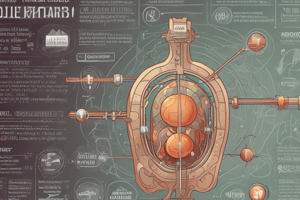Podcast
Questions and Answers
¿Cuál es el factor que influye en la biodisponibilidad de un medicamento administrado por vía oral?
¿Cuál es el factor que influye en la biodisponibilidad de un medicamento administrado por vía oral?
¿Cuál es el mecanismo de absorción que depende de la concentración degradiente de la droga?
¿Cuál es el mecanismo de absorción que depende de la concentración degradiente de la droga?
¿Cuál es el nombre del transporte que utiliza energía para bombear la droga a través de la membrana?
¿Cuál es el nombre del transporte que utiliza energía para bombear la droga a través de la membrana?
¿Cuál es la función de los transportadores de eflujo en la absorción de medicamentos?
¿Cuál es la función de los transportadores de eflujo en la absorción de medicamentos?
Signup and view all the answers
¿Cuál es el nombre de las enzimas que metabolizan medicamentos en la pared del intestino y el hígado?
¿Cuál es el nombre de las enzimas que metabolizan medicamentos en la pared del intestino y el hígado?
Signup and view all the answers
¿Qué tipo de transporte utiliza proteínas transportadoras específicas que se unen a la droga y facilitan su transporte?
¿Qué tipo de transporte utiliza proteínas transportadoras específicas que se unen a la droga y facilitan su transporte?
Signup and view all the answers
¿Cuál es el propósito principal de los antiácidos?
¿Cuál es el propósito principal de los antiácidos?
Signup and view all the answers
¿Qué efecto tienen los anti-diarréicos en el tracto gastrointestinal?
¿Qué efecto tienen los anti-diarréicos en el tracto gastrointestinal?
Signup and view all the answers
¿Cuál es el mecanismo de acción de los laxantes?
¿Cuál es el mecanismo de acción de los laxantes?
Signup and view all the answers
¿Qué tipo de medicamento reduce la secreción de ácido estomacal en la enfermedad de reflux gastroesofágico?
¿Qué tipo de medicamento reduce la secreción de ácido estomacal en la enfermedad de reflux gastroesofágico?
Signup and view all the answers
¿Cuál es el efecto de los antiácidos en el estómago?
¿Cuál es el efecto de los antiácidos en el estómago?
Signup and view all the answers
¿Qué tipo de laxante ablanda las heces?
¿Qué tipo de laxante ablanda las heces?
Signup and view all the answers
¿Cuál es la función de los bloqueadores de histamina-2?
¿Cuál es la función de los bloqueadores de histamina-2?
Signup and view all the answers
¿Qué tipo de anti-diarréico se conoce como Pepto-Bismol?
¿Qué tipo de anti-diarréico se conoce como Pepto-Bismol?
Signup and view all the answers
¿Cuál es el propósito de los laxantes en la medicina?
¿Cuál es el propósito de los laxantes en la medicina?
Signup and view all the answers
¿Cuál es el mecanismo de acción de los antiácidos?
¿Cuál es el mecanismo de acción de los antiácidos?
Signup and view all the answers
Study Notes
Pharmacokinetics in the Digestive System
Bioavailability
- The extent to which a drug becomes available to the target tissue after oral administration
- Influenced by factors such as:
- Solubility and dissolution rate of the drug
- Permeability across the intestinal epithelium
- Metabolism by enzymes in the gut wall and liver
- Blood flow and transport mechanisms
Absorption Mechanisms in the Digestive System
Passive Diffusion
- Movement of drugs across the intestinal epithelium down their concentration gradient
- Depends on:
- Lipid solubility of the drug
- Concentration gradient across the membrane
- Surface area and permeability of the intestinal epithelium
Facilitated Diffusion
- Carrier-mediated transport of drugs across the intestinal epithelium
- Involves specific transport proteins that bind to the drug and facilitate its transport
- Examples: peptide transporters, amino acid transporters
Active Transport
- Energy-dependent transport of drugs across the intestinal epithelium
- Involves specific transport proteins that use energy to pump the drug across the membrane
- Examples: P-glycoprotein, multidrug resistance-associated proteins
Efflux Transporters
- Proteins that pump drugs back into the intestinal lumen, reducing absorption
- Examples: P-glycoprotein, breast cancer resistance protein
Enzymatic Barriers
- Metabolism of drugs by enzymes in the gut wall and liver, reducing bioavailability
- Examples: cytochrome P450 enzymes, esterases
Studying That Suits You
Use AI to generate personalized quizzes and flashcards to suit your learning preferences.
Description
Learn about the processes that affect the bioavailability of orally administered drugs, including absorption mechanisms, efflux transporters, and enzymatic barriers in the digestive system.




